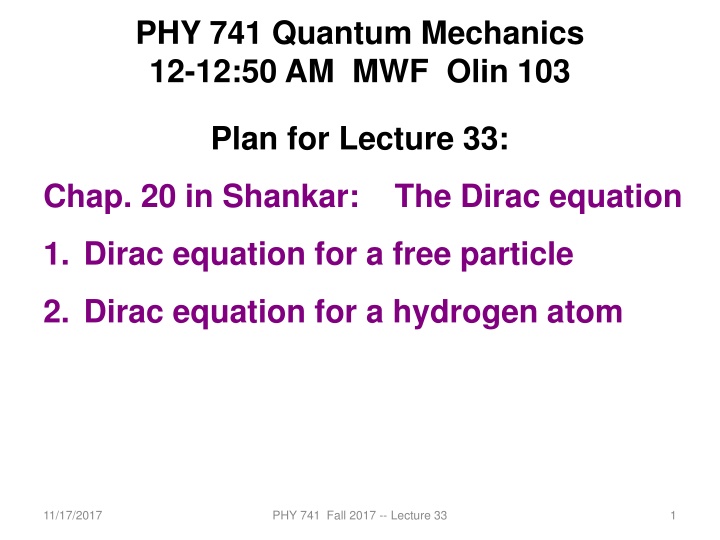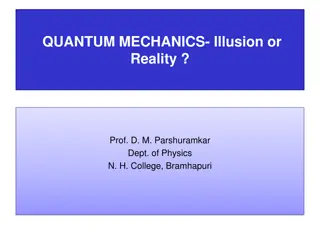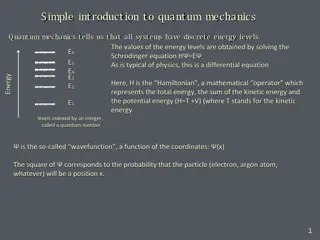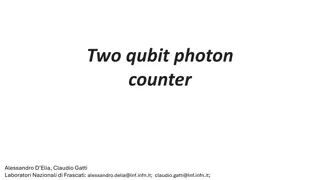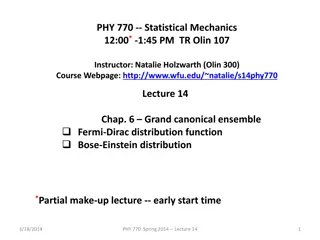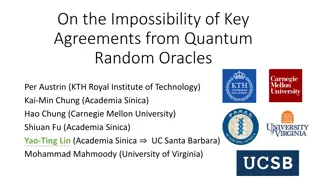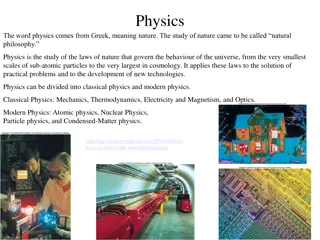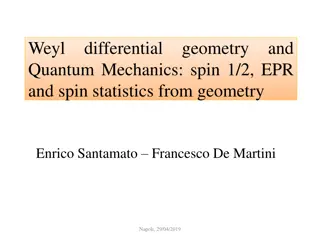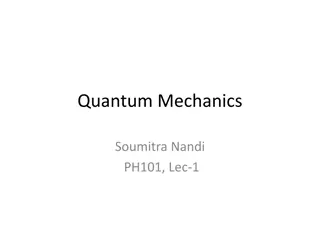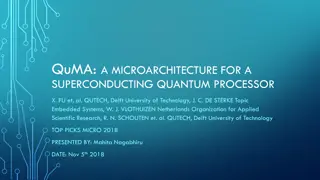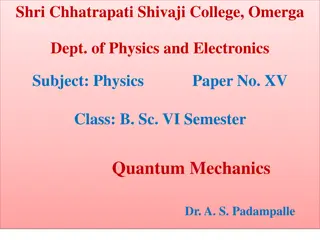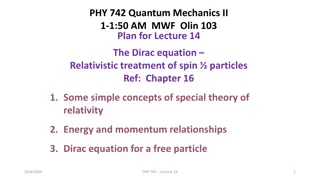Dirac Equation in Quantum Mechanics
Exploring the Dirac equation for free particles and the hydrogen atom in quantum mechanics, this lecture delves into the treatment of Fermi particles in both relativistic and non-relativistic frameworks. The lecture covers the fundamental equations and their rearrangements, highlighting the implications of relativistic relationships on quantum mechanics. Through detailed derivations and discussions, the lecture sheds light on the four-component wavefunction of free Fermi particles and the role of Pauli matrices in the context of positive energy solutions.
Download Presentation

Please find below an Image/Link to download the presentation.
The content on the website is provided AS IS for your information and personal use only. It may not be sold, licensed, or shared on other websites without obtaining consent from the author.If you encounter any issues during the download, it is possible that the publisher has removed the file from their server.
You are allowed to download the files provided on this website for personal or commercial use, subject to the condition that they are used lawfully. All files are the property of their respective owners.
The content on the website is provided AS IS for your information and personal use only. It may not be sold, licensed, or shared on other websites without obtaining consent from the author.
E N D
Presentation Transcript
PHY 741 Quantum Mechanics 12-12:50 AM MWF Olin 103 Plan for Lecture 33: Chap. 20 in Shankar: The Dirac equation 1. Dirac equation for a free particle 2. Dirac equation for a hydrogen atom 11/17/2017 PHY 741 Fall 2017 -- Lecture 33 1
11/17/2017 PHY 741 Fall 2017 -- Lecture 33 2
How do these relationships effect quantum mechanics? Focusing on treatment of Fermi particles Relativistic mechanics Non-relativistic mechanics 2 p ( ) 2 E = = 2 2 2 c 2 p E mc 2 m (with some licens e) = ) ( = ) 2 ( )( p + p 2 E c E c mc i H t p + p i c i c t t ( ) 2 = 2 mc 11/17/2017 PHY 741 Fall 2017 -- Lecture 33 3
Relativistic relationships continued Ref: J. J. Sakurai, Advanced Quantum Mechanics ( ) 2 p + p = 2 i c i c mc t t + p 2 R L Let i c mc t Factored equations: + = 2 L R p i c mc t = 2 R L p i c mc t 11/17/2017 PHY 741 Fall 2017 -- Lecture 33 4
Relativistic relationships continued Ref: J. J. Sakurai, Advanced Quantum Mechanics Factored equations: + = = 2 L R p i c mc t 2 R L p i c mc t = = + U R L Dirac's rearrangement: L R L U U p i c t = 2 m c p c i L L t 11/17/2017 PHY 741 Fall 2017 -- Lecture 33 5
Relativistic relationships continued U U p i c t = 2 mc p c i L L t Further rearrangements: 2 U U p mc p c = i 2 L L t c mc = i H t 11/17/2017 PHY 741 Fall 2017 -- Lecture 33 6
Four component wavefunction of free Fermi particle 2 U mc i = = = + = k U p c = 2 L L t p c mc U U k ( ) ( ) k k r / i iEt Assume e L L k c U L ( ) k k ( ) 2 E k mc c mc L U ( ) k ( ) k 2 E + 2 2 2 c 2 2 4 c E m = + 2 2 c 2 2 4 k E m c 11/17/2017 PHY 741 Fall 2017 -- Lecture 33 7
0 1 1 0 0 i 1 0 0 i = = = Pauli matrices: x y z 0 1 k + k ik z x y = k k ik k k x y z c c c c k = = U L L U ( ) k ( ) k ( ) k ( ) k + 2 2 E m E m = + 2 2 c 2 2 4 c k c + k Positive energy solutions: 1 ( ) 0 = E m z z = = U L N N k ( ) k z 2 E mc k m + + c 0 1 2 E c = U L N N ( ) k ( ) k z 11/17/2017 PHY 741 Fall 2017 -- Lecture 33 8
0 1 1 0 0 i 1 0 0 i = = = Pauli matrices: x y z 0 1 k + k k ik z x y = k k ik k x y z c c k = = U L L U ( ) k ( ) k ( ) k ( ) k + 2 2 E mc E mc = + 2 2 c 2 2 4 c k Negative energy solutions: E m k c 1 0 z z = = U L N N ( ) k ( ) k z 2 E mc k m + c 0 1 2 E c = = U L N N ( ) k ( ) k z 11/17/2017 PHY 741 Fall 2017 -- Lecture 33 9
What does this all mean? Positive energy solutions: = = = + 2 2 c 2 2 4 k E m c 1 0 k c + z = U L N N ( ) k ( ) k z z 2 E mc k m + + c 0 1 = U L N N ( ) k ( ) k 2 E c z 2 2 k + 2 2 k For c m c E mc 2 m 1 0 0 0 = U L N N ( ) k ( ) k 0 1 0 0 = U L N N ( ) k ( ) k 11/17/2017 PHY 741 Fall 2017 -- Lecture 33 10
Dirac equation for free particles 1 0 z = = U L N N ( ) k ( ) k + 0 1 = + 2 2 c 2 2 4 c = = k U L N N ( ) k ( ) k E m mc2 z k c + z z 2 E mc k m + c 2 E c -mc2 1 0 z = = U L N N ( ) k ( ) k = + 2 2 c 2 2 4 c k E m + 0 1 = = U L N N ( ) k ( ) k z 11/17/2017 PHY 741 Fall 2017 -- Lecture 33 11
Dirac equation for a free particle 2 U U p mc p c = i 2 L L t c mc = i H t Other convenient notations in terms of 4 4 matr I = = = = ices 0 0 = p + 2 H c mc 0 0 I 0 1 1 0 0 i 1 0 0 1 0 0 1 i = = I I 2 x y z 0 1 11/17/2017 PHY 741 Fall 2017 -- Lecture 33 12
Dirac equation for Fermi particle in a scalar potential field = p + = 2 For free particle: H c mc 0 0 I = = where: and where: 0 0 I senting a scalar potential fi 0 1 1 0 0 i 1 0 0 1 0 : 0 1 i = = = I I 2 x y z 0 1 Dirac's suggestion for repre eld 0 I I 2 = p + + = 2 ( ) r where H c mc V I I 4 4 0 2 11/17/2017 PHY 741 Fall 2017 -- Lecture 33 13
Dirac equation for electron in the field of a H-like ion 2 H c mc V = + + p ( ) I r 4 For H-like ion with nuclear charge : Z 2 Ze r = = r = Stationary state solutions: ( ) ( ) V V r i H t p U r ( ) ( ) r = / iEt ( , ) r t e L + 2 U U ( ) r ( ) ( ) r ( ) ( r m c V c c V r r r = E + 2 L L p ( ) ) mc 11/17/2017 PHY 741 Fall 2017 -- Lecture 33 14
Dirac equation for electron in the field of a H-like ion -- continued + 2 U U p ( ) ( ) ( ) r ( ) ( ) r mc V r c c r r = E + 2 L L p ( ) mc V r H In order to find an efficient functional form for the eigenfunctions, it is helpful to determine the constants of the motion: 2 J L Total angular momentum: = + in terms of an d J J z 2 + 0 I L 2 = Special opera K t r: o K L 0 I 2 11/17/2017 PHY 741 Fall 2017 -- Lecture 33 15
Digression useful identity for operator vectors A and B ( )( ) ( A A iA B A iA A B iB ) B = + A B A B A B i + + A B iB iC iC A B C iC z x y z x y z x y = + + B iC C x y z x y z x y z where A = + + A B A C B A B A B x x y y z z = B = = = C A B A B C A B A B x y z z y y z x x z C A B A B z x y y x ( )( r ) r r = I 2 2 ( )( ( ) r r )( ) = + i r i r p L 2 2 r r r 11/17/2017 PHY 741 Fall 2017 -- Lecture 33 16
Dirac equation for electron in the field of a H-like ion -- continued ( ) mc c H c mc V + + = + L + 2 p V r = + 2 p ( ) r + 0 L 1 2 z z = J z 0 L 1 2 z z + 2 2 L 0 I I L 3 2 2 J 4 + + Note that: K = 2 2 L 0 L 3 2 4 0 I L 2 = K 0 I + 2 2 2 J 1 4 2 Commutation relations: = = 2 2 J J , 0 , =0 , =0 H K K J z , 0, etc. H K 11/17/2017 PHY 741 Fall 2017 -- Lecture 33 17
Dirac equation for electron in the field of a H-like ion -- continued ( ) ( ) V r c mc + p + 2 U U p ( ) ( ) r ( ) ( ) r mc V r c r r = E 2 L L ( ) ( ) JM r r ( ) ( ) r g r U r ( ) ( ) r We can show that: J JM = if L J More details about spin-angular functions: Eigenfunctions f o J 2 and : J J M z = = + 2 2 J ( 1) JM J J JM J JM M JM z ( ) ( ) 2 = + + = + 2 2 2 ( 1 ) K JM J J JM J JM 1 4 1 2 11/17/2017 PHY 741 Fall 2017 -- Lecture 33 18
Dirac equation for electron in the field of a H-like ion -- continued Eigenvalues of operator: + = K 0 I L 2 K L 0 I 2 U U = K L L U U ( ) 2 = + 2 2 K J 1 2 L L Recall earlier discussion of addition of angular momentum 11/17/2017 PHY 741 Fall 2017 -- Lecture 33 19
Addition of angular momentum - orbital angular momentum and spin angular momentum Clebsch-Gordon coefficients , m m j lm j m = , , , JM j 1 2 j j m j m j m j m J M j 1 2 j 1 1 2 2 1 1 2 2 , 1 2 m = + = or J J l 1 2 1 1 l m 1 2 l 1 2 2 2 s Clebsch-Gordon coefficients for this case: l j s j = = = 1 2 1 2 + + + l M l l M l 1 2 1 2 ( ) ( ) ( ) + = + + ; ; ; l M l l M l M 1 2 1 2 1 2 1 1 2 2 1 2 1 2 1 2 + + 2 1 2 + 1 + + l M l l M l 1 2 1 2 ( ) ( ) ( ) = + + ; ; ; l M l l M l M 1 2 1 2 1 2 1 1 2 2 1 2 1 2 1 2 + + 2 1 2 1 11/17/2017 PHY 741 Fall 2017 -- Lecture 33 20
Another representation of the spin-angular function in terms of spherical harmonic functions and eigenvectors of z 1 0 0 1 + + + l M l l M l 1 2 1 2 ( ) + = + r r ; ( ) ( ) l M l Y Y 1 2 1 2 1 2 1 2 + + + ( ) ( ) l M l M 2 1 2 1 1 0 0 1 + + + l M l l M l 1 2 1 2 ( ) = + r r ; ( ) ( ) l M l Y Y 1 2 1 2 1 2 1 2 + + + ( ) ( ) l M l M 2 1 2 1 11/17/2017 PHY 741 Fall 2017 -- Lecture 33 21
( ) ( ) + = + + + Consider: ; ( 1) ( 1) ; I JM l J J l l I JM l L 1 2 1 4 1 2 2 2 = Possibilities: J l = ; J M l 1 2 = + = = 1 J l l 1 2 1 2 l Combinations: = = = 1 +1 1 2 1 +2 3 2 3 3 + 0 j l 1 2 1 2 3 2 3 2 5 2 5 2 2 11/17/2017 PHY 741 Fall 2017 -- Lecture 33 22
( ) ( ) JM r r ( ) ( ) r g r U r ( ) ( ) r J JM = if L J Next time, we will show that the coupled radial equations take the form: 1 1 dg g E dr r df f E dr r c Question: How do these results reduce to the Schroedinger equation in the non-relativistic limit What new physics is contained more generally? + ( ) + = + 2 ( ) mc V r f c 1 1 ( ) = 2 ( ) r mc V g 11/17/2017 PHY 741 Fall 2017 -- Lecture 33 23
